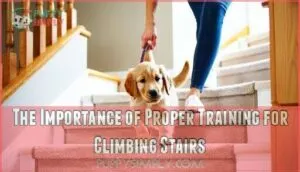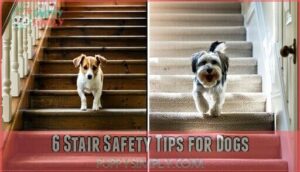This site is supported by our readers. We may earn a commission, at no cost to you, if you purchase through links.

Young puppies lack coordination, while senior dogs may struggle with joint pain or mobility issues. Breeds with long backs like dachshunds face higher injury risks, and dogs with hip dysplasia or arthritis shouldn’t tackle stairs regularly.
The key is evaluating your dog’s individual needs and physical capabilities. Most healthy adult dogs handle stairs just fine with proper training and supervision.
However, steep, slippery, or poorly lit stairs create hazards for any dog. Your four-legged friend’s safety depends on several factors that determine whether those steps are friend or foe.
Table Of Contents
- Key Takeaways
- Factors to Consider When Deciding if Stairs Are Bad for Dogs
- The Impact of Stairs on Dogs
- The Importance of Proper Training for Climbing Stairs
- How to Make Stairs Easier for Dogs
- 4 Cases When Stairs Pose Danger to Dogs
- Stairs for Puppies
- 6 Stair Safety Tips for Dogs
- Frequently Asked Questions (FAQs)
- Are stairs bad for your dog?
- What dog breeds should avoid stairs?
- Can stairs cause hip dysplasia in dogs?
- Why can’t dogs go up stairs?
- Can dogs develop arthritis from using stairs?
- Are spiral stairs more dangerous than straight stairs?
- Should dogs wear booties on outdoor stairs?
- How many stairs are safe for daily use?
- Do carpet stairs cause more allergies in dogs?
- Conclusion
Key Takeaways
- Age matters most – Don’t let puppies under 12 weeks use stairs since their joints are still developing, and watch senior dogs closely as arthritis makes climbing painful and dangerous.
- Breed genetics create risks – Long-backed breeds like Dachshunds face spinal injury risks, while large breeds prone to hip dysplasia shouldn’t climb stairs frequently during their growth period.
- Medical conditions change everything – If your dog has arthritis, hip dysplasia, or IVDD, stairs can worsen their condition and cause permanent damage, so consult your vet before allowing regular use.
- Make stairs safer with simple fixes – Add grip surfaces, improve lighting, supervise climbing, and consider alternatives like ramps or carrying your dog when stairs pose too much risk.
Factors to Consider When Deciding if Stairs Are Bad for Dogs
Whether stairs are bad for your dog depends on several important factors you’ll need to evaluate carefully.
Consider your dog’s age, breed, the stairs’ size and condition, and any existing medical conditions before allowing regular stair use.
Age of The Dog
Your dog’s age dramatically affects stair safety, with each life stage presenting unique challenges. Puppy Development requires careful timing—introduce stairs after 12 weeks when coordination improves. Adult Agility typically handles stairs well, but monitor for early signs of dog joint pain.
Senior Mobility becomes essential as Age-Related Arthritis develops, making senior dog stairs potentially dangerous.
- Puppies under 12 weeks: Wobbly legs and poor coordination increase fall risk
- Adult dogs (1-7 years): Peak physical condition allows confident stair navigation
- Senior dogs (8+ years): Dog arthritis stairs become problematic as dog mobility issues worsen
Lifespan Considerations mean what’s safe at one age may become hazardous later.
Dog’s Breed
Beyond age considerations, your dog’s breed plays a major role in stair safety.
Breed predisposition determines how well your furry friend handles those steps.
Small breeds like Dachshunds and Corgis face spinal concerns due to their long backs and short legs—think of them as four-legged hot dogs trying to navigate a jungle gym.
Large breeds such as German Shepherds and Labradors deal with genetic issues like hip dysplasia, where joint problems can worsen with repeated stair climbing.
Certain breeds are also genetically predisposed to developing joint problems, further complicating stair use.
Size matters in regard to breed-specific risks.
Bulldogs and Pugs struggle with joint stress, while tiny Chihuahuas might find standard stairs overwhelming.
Dog breed characteristics directly influence stair tolerance, so understanding your dog’s genetic makeup helps you make informed decisions about their daily navigation needs.
Size of The Stairs
Stair dimensions directly impact your dog’s safety and comfort.
Step height and tread depth create challenges for different-sized pets – high steps strain small dogs while shallow treads cause large dogs to bunch up awkwardly.
Stair angle affects balance, with steep angles increasing fall risks.
Proper stair width accommodates your dog’s natural gait, while narrow stairwells create anxiety and navigational difficulties.
Condition of The Stairs
Why do outdoor stairs cause more slips than indoor ones?
The stair material, stair height, and stair angle all impact whether stairs are bad for dogs.
Poor stair design creates safety hazards:
- Slippery surfaces – Wood, metal, or wet materials increase fall risks
- Steep angles – Hard-to-navigate stairwells challenge dog mobility
- Inadequate grip surfaces – Smooth treads offer no traction for paws
Proper stair safety requires evaluating these conditions before allowing access.
Medical Conditions
Several medical conditions make stairs risky for your furry friend.
Arthritis affects up to 20% of adult dogs, causing joint pain that worsens with stair climbing.
Hip dysplasia impacts up to 70% of large breeds like German Shepherds, creating biomechanical stress on hip joints.
Intervertebral Disc Disease (IVDD) affects 25% of certain breeds, particularly Dachshunds, increasing spinal injury risks.
Dogs with joint problems or spinal issues need careful evaluation before using stairs regularly.
Addressing these issues early can improve their quality of life, and regular veterinary check-ups are essential for early detection, which is a critical step in maintaining their health and preventing further joint pain and spinal injury, ultimately leading to a better quality of life.
The Impact of Stairs on Dogs
Stairs can affect your dog differently depending on their age, breed, and health status.
Understanding these impacts helps you make informed decisions about your pet’s safety and mobility around your home.
Impact on Older Dogs
As dogs age, stairs become increasingly challenging due to joint pain and mobility decline.
Older dogs with arthritis experience significant discomfort when climbing stairs, as this activity increases joint stress and accelerates cartilage wear.
Vision impairment and cognitive changes make navigation even more difficult, leading to hesitation and potential falls.
Joint health deteriorates naturally with age, making stairs feel like climbing mountains for your senior pup.
Dogs with diagnosed arthritis show reduced mobility when frequently using stairs, and repeated climbing can worsen their condition.
Poor balance and coordination increase fall risk, potentially causing fractures or soft tissue injuries.
Dog joint care becomes essential as muscle weakness develops.
Arthritis management often requires limiting stair use, as veterinarians recommend avoiding activities that exacerbate symptoms.
Many owners wonder "are stairs bad for dogs" when they notice their aging companion struggling with previously easy climbs.
Impact on Puppies
While tiny paws traversing steps might seem adorable, puppies face unique stair risks that require careful consideration. Joint Development remains vulnerable during puppyhood, making stairs potentially harmful to growing bones and cartilage. Breed Predisposition plays a vital role—large breeds like German Shepherds shouldn’t attempt stairs until 8-12 months old due to hip dysplasia risks.
Those adorable puppy paws aren’t ready for stair climbing—wait until their joints can handle the challenge.
Stair Introduction timing matters substantially:
- Wait until 12-16 weeks for small breeds under veterinary guidance
- Assess coordination levels before allowing independent climbing
- Start with 2-3 steps to gauge comfort and ability
- Block access until mastery is demonstrated consistently
Training Methods should emphasize positive reinforcement with treats and patience. Psychological Impact from falls can create lasting stair phobias, making gradual introduction essential.
Puppy stairs safety depends on supervision, while puppy stair risks include broken bones and spine injuries. Understanding puppy joint care prevents long-term mobility issues through proper puppy stairs training. Consider using stair treads for safety to improve traction and grip.
Impact on Dogs With Medical Conditions
While puppies need time to develop coordination, dogs with medical conditions face different challenges when climbing stairs.
Medical conditions create unique dog health concerns that require careful attention. Joint Stress becomes a major factor for dogs with arthritis, hip dysplasia, or other joint issues.
Stairs can worsen these conditions by placing additional strain on already compromised joints. Arthritis Impact shows up as increased pain and stiffness after stair use, while Hip Dysplasia symptoms may flare up with repeated climbing.
| Condition | Stair Risk Level |
|---|---|
| Arthritis | High – increases joint pain |
| Hip Dysplasia | Very High – worsens degeneration |
| IVDD | Extreme – can cause paralysis |
IVDD Risks are particularly serious for breeds like Dachshunds. Intervertebral Disc Disease IVDD can lead to permanent damage if dogs fall or twist wrong on stairs.
Post-Surgery recovery also requires stair restrictions to prevent re-injury. Certain small breeds are also prone to tracheal collapse, which can be exacerbated by the strain of climbing stairs.
Your vet can assess whether dog stairs risks outweigh benefits for your specific situation. Don’t guess – get professional guidance for dogs with medical conditions.
The Importance of Proper Training for Climbing Stairs
Teaching your dog to navigate stairs properly isn’t just helpful—it’s essential for their safety and your peace of mind.
Whether you’re introducing a nervous puppy to their first steps or helping a senior dog maintain confidence, the right training approach makes all the difference.
Teaching Dogs to Navigate Stairs
Successfully teaching your dog stair navigation requires patience and the right approach. Confidence building starts with gradual exposure—let your pup explore stairs without pressure first.
Here’s effective step-by-step guidance for dog stairs training:
- Start small: Begin with just one or two steps, using the lure and reward technique with high-value treats
- Practice positive reinforcement: Reward each successful step immediately with praise and treats
- Consider breed considerations: Large breeds prone to hip dysplasia need extra caution during training
For overcoming fear, place treats on each step to create positive associations. Short training sessions work best—under five minutes prevents fatigue. Remember that stair navigation skills take time to develop. For older dogs, stairs can help reduce stress on joints. Some dogs master stair climbing quickly, while others need weeks of consistent practice. The key is making each session enjoyable rather than stressful, ensuring your dog associates stairs with good experiences rather than anxiety.
Training Dogs to Walk Safely on Stairs
Building confidence during dog stairs training requires patience and the right approach. Your furry friend needs time to master this skill safely.
Start with Gradual Introduction by placing your dog at the bottom step with treats waiting above. Use Positive Reinforcement immediately when they take each step correctly. Leash Guidance helps nervous dogs feel secure while learning proper foot placement and timing.
Confidence Building happens through repeated success, so practice short sessions daily. Stair Desensitization works best when you let your dog explore at their own pace without rushing.
| Training Method | Best For |
|---|---|
| Treat placement on steps | Puppy stair training |
| Leash support | Anxious or elderly dogs |
| Short practice sessions | Dog stair climbing beginners |
Remember that every dog learns differently. Some master stairs quickly while others need weeks of patient practice. Keep sessions positive and stop if your dog shows stress or fatigue.
Training Dogs to Avoid Stairs
Sometimes you need to teach your dog that stairs are off-limits entirely. This approach works best for puppies under 12 weeks, senior dogs with joint issues, or breeds prone to hip dysplasia.
Start with command training using "stay" or "wait" at the bottom of stairs. Positive reinforcement with treats and praise helps your dog understand boundaries.
Place baby gates to physically block access while you’re working on behavioral training. For puppy stair safety training, redirecting behavior is key.
When your pup approaches stairs, guide them to alternative exercises like walking on flat surfaces or using ramps. Make these activities more rewarding than stair climbing.
Safety measures include consistent supervision during puppy training sessions. Never punish your dog for approaching stairs – instead, calmly redirect and reward good choices.
Some dogs need permanent stair restrictions, especially those with back problems or joint conditions. Remember, puppy stair training takes patience.
Your four-legged friend will learn these boundaries with consistent practice and positive experiences.
How to Make Stairs Easier for Dogs
Making stairs safer for your dog doesn’t require a complete home renovation. Simple stair modifications can transform treacherous steps into manageable pathways.
Consider these dog stairs alternatives when traditional climbing becomes challenging:
- Install carpet treads or non-slip strips – These provide vital traction and cushioning for paws
- Add ramp alternatives alongside existing stairs – Perfect for dogs with mobility issues
- Use assistive devices like portable dog stairs – Great for accessing furniture or vehicles
- Implement training techniques with positive reinforcement – Teaching proper stair navigation prevents accidents
- Schedule a veterinary consult to assess your dog’s physical capabilities – Professional guidance helps guarantee appropriate modifications
These dog stair training tips focus on prevention rather than reaction. You can find various dog stair tread options to improve your dog’s safety.
A ramp for dogs offers gentler inclines, while proper lighting eliminates shadows that confuse depth perception. Remember, dog stairs benefits extend beyond convenience – they’re about maintaining your pet’s independence and confidence throughout their lifetime.
4 Cases When Stairs Pose Danger to Dogs
While most dogs can handle stairs just fine, certain situations make stair climbing risky and potentially harmful.
You’ll need to watch for specific warning signs that indicate when stairs become a safety hazard for your furry friend, and be aware of situations that make stair climbing potentially harmful.
Dogs With Genetic Physiological Issues
Certain dog breeds face heightened IVDD risk and spinal issues due to genetic predisposition.
Dachshunds, Corgis, and other breeds with elongated spines struggle with stairs, while large breeds like Labradors carry hip dysplasia risks.
These breed-specific risks mean stairs aren’t just challenging—they’re potentially dangerous.
Your dog’s genetics basically load the dice against safe stair navigation, making joint health a primary concern.
Dogs With (Specific) Health Issues
When your dog battles specific health conditions, stairs can feel like climbing Mount Everest.
When health issues hit, stairs become your dog’s personal Everest – every step a painful summit to conquer.
Dogs with arthritis experience increased joint discomfort and inflammation when traversing steps, making each climb painful.
Hip dysplasia creates additional joint stress as weakened hip joints struggle under pressure.
IVDD risks skyrocket for breeds with elongated spines, while breed predisposition plays a vital role in determining safety.
Medical conditions like neurological disorders impair coordination, increasing fall risks.
Joint issues don’t just cause pain—they progressively worsen with repetitive stair use.
Arthritis impact becomes more severe over time, creating a cycle where stairs aggravate existing problems.
Your veterinarian can assess whether your dog’s specific condition makes stairs unsafe.
Some dogs benefit from anti-inflammatory medications or supportive harnesses, while others need complete stair avoidance to prevent further joint damage.
In these cases, preventing further joint damage is crucial for the dog’s well-being.
Dogs With Injuries
When your dog’s already dealing with injuries, stairs become a minefield of potential complications. Even healthy dogs face risks—one in three pet owners report their dog has been hurt on staircases. For injured canines, these structures can worsen existing conditions or cause reinjury.
Your injured dog needs special consideration around stairs. Here’s what to focus on:
- Fall Prevention – Block stair access completely during recovery periods
- Injury Severity Assessment – Work with your vet to determine if stairs are safe
- Recovery Strategies – Use ramps, carry your dog, or install assistive devices
- Veterinary Care Monitoring – Regular check-ups help track healing progress
Pain management through acupuncture or other treatments can support recovery. Canine rehab centers often provide mobility aids like padded steps for dogs who can’t navigate regular stairs safely. Consider installing skid-resistant stair treads to help prevent slips. Don’t rush the healing process—preventing dog injury means taking stairs out of the equation until your vet gives the all-clear.
Senior Dogs
With age comes wisdom, but also creaky joints that make stairs treacherous for senior dogs.
Joint health deteriorates as arthritis sets in, causing pain and stiffness that transforms once-simple climbs into painful ordeals.
Muscle loss reduces their strength and balance, while cognitive decline can confuse familiar routes.
Watch for signs your dog struggles—hesitation, whimpering, or limping after stair use.
Mobility aids like ramps or carrying your companion can prevent stairs bad for dogs situations.
Pain management through veterinary care helps address underlying joint issues, keeping your faithful friend comfortable and safe, ensuring their joint health and overall well-being, and providing effective pain management.
Stairs for Puppies
Climbing stairs can be tricky business for your furry friend, especially when they’re still growing. Puppy Stair Age matters tremendously—most experts recommend waiting until your pup reaches 12 weeks before introducing stairs. Large breeds with Breed Predisposition to hip dysplasia should wait even longer, sometimes up to eight months.
Joint Development is vital during puppyhood. Those adorable little legs are still forming, and repeated stair climbing can stress growing joints. Hard Stair Material like wood or metal increases injury risk, while carpeted steps provide better traction.
Consider these puppy stair safety essentials:
- Start with just 2-3 steps during initial Training Methods
- Use treats and positive reinforcement to build confidence
- Block access until your puppy masters controlled climbing
Puppy stair injuries can range from minor tumbles to serious fractures. Small breeds face different challenges than larger ones—their size makes falls more dangerous. Puppy stair climbing age varies by breed, but patience pays off. Proper puppy stair precautions include constant supervision and gradual introduction. Remember, puppy stair safety tips aren’t just suggestions—they’re essential for preventing long-term joint problems.
6 Stair Safety Tips for Dogs
You can take several simple steps to keep your dog safe on stairs and prevent injuries.
These practical tips will help you create a safer environment whether your dog is a confident climber or needs extra support.
Supervision
Three key principles guide effective puppy stair supervision: constant monitoring, early intervention, and preventative measures.
Never leave your pup unattended on stairs, especially during supervised playtime when excitement can lead to accidents.
Watch for signs of hesitation or fatigue that signal when stairs bad for dogs situations might develop.
Puppy stair supervision requires patience as you guide gradual independence through puppy stair monitoring.
Implement unattended stair safety by blocking access when you can’t watch them closely.
Improve Visibility
Poor visibility turns stairs into hazardous obstacles for dogs, especially senior pups with failing eyesight.
Night lights illuminate indoor stairways, while outdoor lighting brightens exterior steps during evening walks. Motion sensors automatically activate when your dog approaches, providing instant visibility.
Reflective tape along stair edges creates color contrast that helps dogs judge distances better. These simple visibility improvements substantially reduce stairs bad for dogs scenarios.
Dog stairs safety products like LED strips make navigation easier, while proper lighting serves as one of the most effective dog stair alternatives to complete avoidance, improving overall dog stairs safety and reducing the risk of accidents on hazardous obstacles, and enhancing night lights illumination.
Clean The Way
Looking beyond good lighting, keeping your stairs spotless protects your furry friend from unnecessary hazards.
A clean pathway prevents slips and falls that could lead to serious dog stairs injury. Regular stair surface hygiene removes tracked dirt and debris that make surfaces slippery.
Essential cleaning steps for dog safety:
- Sweep daily – Remove loose dirt, hair, and debris before they become slip hazards
- Use pet-safe cleaners – Avoid harsh chemicals that could harm paws or cause respiratory issues
- Disinfect weekly – Kill bacteria and germs while maintaining cleaning product safety standards
- Apply odor elimination methods – Fresh-smelling stairs encourage confident climbing and prevent avoidance behaviors
Grip Surfaces
Adding grip surfaces transforms slippery stairs into safe pathways for your furry friends.
Think of these surfaces as your dog’s safety net—they provide the traction needed to prevent dangerous slips and falls.
| Surface Type | Best For |
|---|---|
| Carpet vs. Tread | Indoor stairs needing soft cushioning |
| Rubberized Runners | Outdoor stairs requiring weather resistance |
| Anti-Slip Coating | Permanent solutions on concrete or wood |
| DIY Grips | Budget-friendly adhesive tape options |
| Stair Material Enhancement | Existing surfaces needing quick upgrades |
These antislip surfaces reduce injury risk by providing secure footing, especially for older dogs or breeds prone to joint issues.
Consider installing specialized stair coverings for enhanced safety.
Carry Your Dog
When grip surfaces aren’t enough, carrying your dog becomes your safety net. Sometimes you’ll need to scoop up your furry friend to prevent potential injuries, especially for small breeds or dogs with mobility issues.
Proper carrying techniques involve supporting both the chest and hindquarters while keeping your dog close to your body. Consider breed considerations and weight limits—you shouldn’t strain yourself trying to carry a Great Dane up two flights.
For injury prevention, use a harness or secure grip, and move slowly to avoid startling your pet. A dog carrying harness can provide added security. Alternative solutions include pet ramps or stair gates for regular use.
Frequently Asked Questions (FAQs)
Are stairs bad for your dog?
Stairs aren’t inherently evil for dogs, but they’re like kryptonite for certain breeds and puppies.
Young pups under 12 weeks and large breeds prone to hip dysplasia should avoid them until stronger.
What dog breeds should avoid stairs?
Small breeds with long spines like Dachshunds and Basset Hounds should avoid stairs due to spinal injury risks.
Large breeds prone to hip dysplasia, including German Shepherds, Golden Retrievers, and Great Danes, shouldn’t use stairs frequently to prevent joint damage.
Can stairs cause hip dysplasia in dogs?
While you might worry stairs don’t directly cause hip dysplasia, they can worsen existing genetic predispositions.
Repetitive stair climbing stresses developing joints in puppies, potentially accelerating arthritis in vulnerable breeds like German Shepherds and Golden Retrievers, which can be a significant concern for their health.
Why can’t dogs go up stairs?
Dogs can go up stairs, but some face challenges due to age, breed, or physical limitations.
Puppies lack coordination, while breeds with joint issues or short legs may struggle with balance and safety, which can be a significant challenge.
Can dogs develop arthritis from using stairs?
Large breed puppies face a 20% higher risk of hip dysplasia when frequently climbing stairs during their growth period.
Yes, you’re right to worry—repetitive stair climbing can contribute to arthritis development, especially in breeds already prone to joint issues like German Shepherds and Golden Retrievers.
Are spiral stairs more dangerous than straight stairs?
Spiral stairs pose greater risks than straight stairs for dogs.
They’re trickier to navigate, especially for pups with balance issues or vision problems.
The curved steps can throw off your dog’s depth perception, making slips more likely, due to the stairs’ tricky nature and potential impact on your dog’s balance.
Should dogs wear booties on outdoor stairs?
Like knights of old donning armor for battle, you’ll want booties on icy or wet outdoor stairs.
They provide essential traction and protect paws from salt, chemicals, and rough surfaces that cause slipping or injury.
How many stairs are safe for daily use?
Most healthy adult dogs can safely use 10-15 stairs daily. Puppies under 12 weeks and seniors with joint issues need restrictions. Monitor your dog’s comfort level and adjust accordingly.
Do carpet stairs cause more allergies in dogs?
Carpet stairs don’t directly cause more allergies in dogs, but they can trap allergens like dust mites, pollen, and dander that trigger reactions in sensitive pups.
Conclusion
Addressing the stair question isn’t black and white—it’s more like walking a tightrope between safety and mobility.
Whether stairs are bad for dogs depends entirely on your pup’s unique circumstances.
You’ve learned that age, breed, health conditions, and stair quality all play vital roles.
Remember, proper training and supervision can transform potentially dangerous steps into manageable pathways.
Trust your instincts, consult your vet when needed, and prioritize your dog’s individual capabilities over one-size-fits-all rules, considering their overall health conditions.














